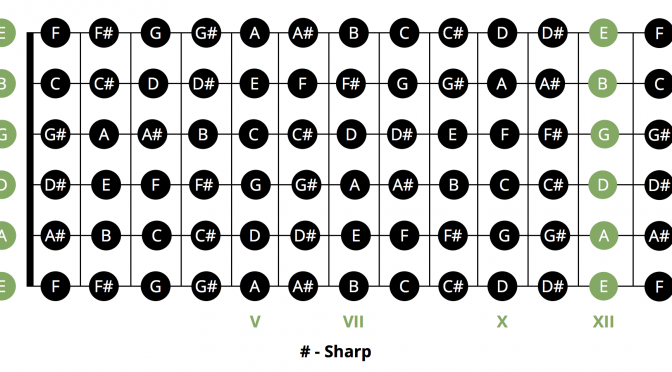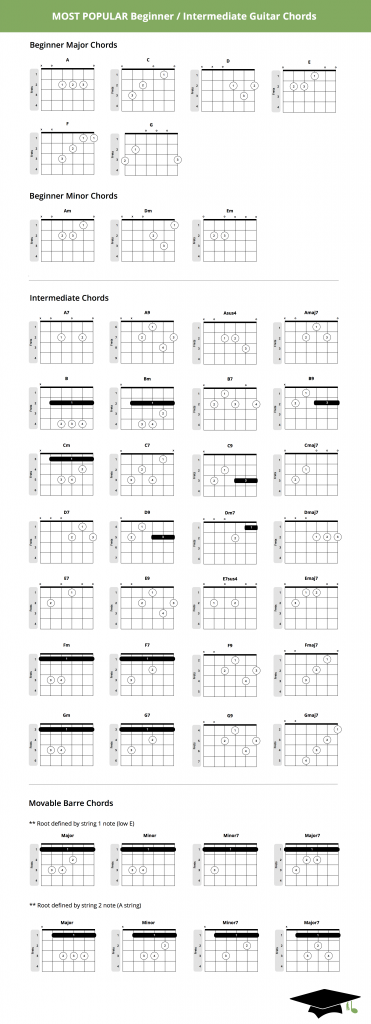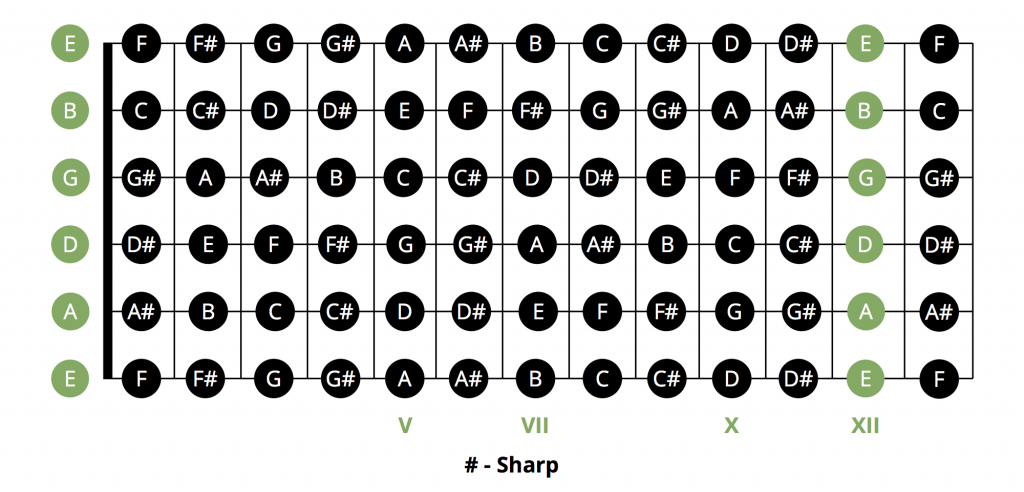
This post is part of a wider collection of articles, which will be published on the Pro Music Tutor blog in the coming weeks. This series is based on the excellent collection of educational blogs available at MusicianTuts.com. Pro Music Tutor would like to thank Cody at Musician Tuts for allowing us to collaborate with him and to use his work as the basis for this series.
All images used in this post are courtesy of Musician Tuts.
The Essential Guitar Chords Chart
Having looked at the basics of what a guitar chord is and then moving onto look specifically at barre chords, we’re going to move onto looking at a useful guitar chords chart.
While there is a huge number of guitar chords that you might want to play, and that we’re sure you’ll learn as you move on your journey of learning and improving your guitar playing, at this stage we’re focusing specifically on chords that beginner guitarists and intermediate guitarists will be commonly looking to practice.
This is a great guitar chords chart to call upon for learning new songs as well as for composing your own.
 With the last section at the bottom – moveable barre chords – you can use these finger positions to play a range of chords depending on your choice of root note.
With the last section at the bottom – moveable barre chords – you can use these finger positions to play a range of chords depending on your choice of root note.
The root note of the first row of moveable barre chords is defined by the low E string. For example, if you were to take the first example (Major) and use those finger positions starting from the 5th fret, you would get an A major. This is because the 5th fret of the low E string is an A note, and therefore the root note of this chord.
The diagram below is an outline of all the notes for each string within the first 12 frets of a guitar. Once you know how to play each note, it will open up a whole range of possibilities for scales, arpeggios, and other great sounds.
To help explain the image above a little further, the notes in green on the far left are the open string notes. Each column corresponds to a fret on the guitar and each note is different all the way up until the 12th fret where everything begins to repeat again. This is an important lesson to remember. The notes on the 12th fret are the same as the open string notes, only they are 1 octave higher. This means that after the 12th fret, the notes repeat themselves, only they are all an octave higher. For example, the notes on fret 1 are the same as fret 13, the notes on fret 2 are the same as fret 14, and so on.
In the next post we will move onto looking at chord progression.
Check out the original Beginner Guitar Chords post at Musician Tuts.
Are you a guitarist? Check out our full range of online guitar lessonsAre you a saxophonist? Check out our full range of online saxophone lessons
Subscribe to Pro Music Tutor from as little as £7.99 per month
Related Posts
-
The Benefits of Online Music Education
Learning music has never been easier, since the internet and modern technological advancements have opened the doors to countless possibilities, expanding the subjects people can choose from and how the lessons are taught. Now, people can study a whole host of music-related topics; from learning to play guitar or DJing, to understanding the inner workings […]
View All >> -
Essential Jazz Guitar Scales that are Easy to Learn
Improvising in jazz requires the ability to play in different keys over different chords. Results certainly do not come overnight, but with diligent practice, you would be surprised by what you can achieve. Many people ask me about what scales I use as if they were some big secret. While knowing your scales is very […]
View All >>
Latest Blog Entries
-
The Benefits of Online Music Education
Learning music has never been easier, since the internet and modern technological advancements have opened the doors to countless possibilities, expanding the subjects people can choose from and how the lessons are taught. Now, people can study a whole host of music-related topics; from learning to play guitar or DJing, to understanding the inner workings […]
View All >> -
Essential Jazz Guitar Scales that are Easy to Learn
Improvising in jazz requires the ability to play in different keys over different chords. Results certainly do not come overnight, but with diligent practice, you would be surprised by what you can achieve. Many people ask me about what scales I use as if they were some big secret. While knowing your scales is very […]
View All >>
Blog Categories
- Categories
- Guitar Tips (93)
- History (36)
- How-To (38)
- Interviews (3)
- Music Industry (121)
- Prolinks Guitar (2)
- Prolinks Lessons (3)
- Prolinks Tutor's Profile (1)
- Saxophone Tips (40)
- Uncategorized (6)
Tags
Archive
- November 2018 (1)
- February 2018 (1)
- December 2017 (1)
- November 2017 (1)
- October 2017 (1)
- July 2017 (4)
- May 2017 (2)
- April 2017 (1)
- August 2016 (2)
- July 2016 (1)
- June 2016 (2)
- May 2016 (3)


